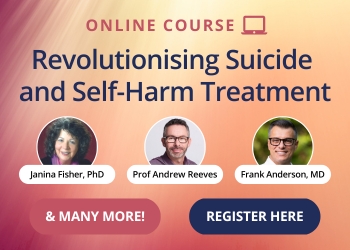Accompany your clients from risk to resilience with newfound confidence!
It’s natural for therapists to feel alarm, even dread, when a client expresses suicidal thoughts, reports escalating self-destructive behaviours or is having a mental health crisis.
But what if this rock-bottom moment could become the starting point of your client’s resilience and recovery?
The reality is, when risk levels rise your powers of empathy and connection matter more than ever.
Which is why this targeted course is designed, not to replace your crucial relational skills, but to complement them with the latest frontline interventions…
… so that you can rapidly build your confidence and effectiveness with suicidality and self-harm and restore hope to clients in the depths of their distress.
With trusted guidance from international leading voices including Janina Fisher, Frank Anderson, Andrew Reeves, Lisa Ferentz and more, these eight self-paced modules bring together the most up-to-date evidence-based modalities available to help you:
- Reduce severe dysregulation, shutdown and overwhelm in self-harming and suicidal clients, with Internal Family Systems Therapy (IFS) and Trauma Informed Stabilization Treatment (TIST)
- Get beyond dehumanising ‘tick-box’ risk assessment tools – to work calmly, collaboratively and creatively in the face of suffering and despair
- Target the root causes of suicidal ideation and self-injury, using Cognitive Processing Therapy (CPT), Deep Brain Reorienting (DBR) and Comprehensive Resource Model (CRM)
- Grasp the neurobiology behind why your clients are hurting themselves to try to help themselves – and use Dialectical Behaviour Therapy (DBT) and the CARESS model to provide healthier alternative strategies that both protect and empower
Packed with practical skills and insights from Internal Family Systems Therapy (IFS), Cognitive Processing Therapy (CPT), Dialectical Behaviour Therapy (DBT), EMDR plus many more, this course will provide both the rapid skills boost and the relational grounding you need to transform how you feel about working with risk.
You can’t always predict when a client will find themselves in crisis. But you can be ready for anything that comes your way.
Proven Contemporary Interventions for Clients in Crisis
- Directly target the trauma, shock and attachment wounding beneath your client's unbearable pain, with EMDR, Deep Brain Reorienting (DBR) and Comprehensive Resource Model (CRM)
- Restore agency and reduce guilt and shame to release your client from self-destructive cycles and ‘revolving-door’ therapy, with Dialectical Behavioural Therapy (DBT) and CPT (Cognitive Processing Therapy)
- Build safety by getting into relationship, including with your client’s most alarming or extreme parts, using Internal Family Systems Therapy (IFS) and Trauma Informed Stabilization Treatment (TIST)
- Engage in essential dialogue around suicide risk – and where to explore the symbolic meaning of self-harm
- Plus… receive vital guidance on addressing practitioner attitudes and activation around suicidality and risk

“Working with suicide is a relational process, not a procedural one”
-Dr Andrew Reeves, suicide and self-harm treatment specialist, trainer and author
When we’re facing a client's suicidality, we’re forced to confront our own attitudes towards living and dying. Professor Andrew Reeves considers how to approach the subject calmly and confidently in the face of uncertainty so that your clients feel met and understood in the depth of their pain and distress.
You’ll learn how to work collaboratively with your clients when they are in crisis, so that they can share and explore their most frightening feelings and find safety through greater self-understanding.
Loneliness can be a killer – but there are powerful interventions that can restore our client’s capacity to connect with others.
Sanja Oakley, MA, explores international suicide trends and identifies high risk groups and populations before providing an overview of three evidence-based, bottom-up modalities that address the root causes of suicidal ideation deep in the brain.
These modalities are Deep Brain Reorienting (DBR), Comprehensive Resource Model (CRM) and Eye Movement Desensitization and Reprocessing (EMDR) – the approach you may have seen Sanja undertaking with Prince Harry in his 2021 mental health documentary ‘The Me You Can’t See’. They can all help you to directly target the trauma, shock and attachment wounding that must be processed for healing to take place.

“[There’s an] alternative to standard safety contracts that doesn’t evoke power struggles or re-enact the victim-perpetrator dynamic”
-Lisa Ferentz, LSCSW-C, trauma treatment specialist and international consultant
When clients hurt themselves to help themselves, it’s because they don’t know how else to handle their overwhelming pain. But self-harm can lead to guilt, shame and fear, leaving clients more vulnerable to the next triggering event. Lisa Ferentz, LCSW-C, shows you how you can educate your clients about this self-destructive cycle of behaviour and help them replace self-harm with healthier alternatives.
Lisa shares the highly effective CARESS model, which teaches clients how to identify and respond differently to self-harming impulses, building a sense of choice, control and self-compassion. The model also creates space to explore the meaning of the self-harm, which may be telling a story of past trauma without words.
For suicidal clients, the fear of being overwhelmed by one’s own emotions can overpower even the fear of death.
Janina Fisher, PhD, shares her parts-based and trauma-focused approach, helping clients understand their unsafe behaviour as desperate attempts to self-regulate. She’ll show you how to educate clients on the separation between their “Selves” and their “suicidal parts”. You’ll learn a variety of mindfulness-based strategies to help clients manage their distress, plus you’ll become familiar with the common mistakes therapists run into so you can watch out for them in your own practice.

“When we really listen, our client’s suicidal parts are saying to them: ‘I’m your last best bet’. And we can say... what if there was another way to work with your pain?”
-Cece Sykes, LCSW, senior Internal Family Systems (IFS) senior trainer and consultant
When we see the aftermath of self-harm or even suicide attempts with our clients... it can be difficult to see the positive intentions behind these acts. But using the Internal Family Systems (IFS) Therapy model, Frank Anderson, MD, shows you why these parts need recognising and appreciating.
Frank will give you methods to help the client’s ‘Self’ open direct communication with their self-harming part, so that it can feel understood and be freed up to take on healthier roles. We’ll also consider which of our own parts may get activated in this challenging work.
Whether clients are engaging in cutting, heavy substance use, reckless sex, compulsive gaming or disordered eating, these self-harming and addictive behaviours all have a purpose. Traditional approaches have tried to help clients get in control of their compulsive activities. But what if the key is to get into relationship with themselves? Cece Sykes, LCSW shows how you can use Internal Family Systems (IFS) Therapy to work with the parts of the client that drive these behaviours. These parts have been busy doing all the wrong things for the right reasons – whatever they think it takes to distract from pain or put out emotional fires.
You’ll discover why the best way to regulate a client’s whole system is to start listening intently to their most alarming parts. Building on Module 5, you'll learn more about how to offer self-harming parts new ways to soothe and protect, so that our clients are free to leave behind addictive, self-destructive behaviours.

“Acceptance doesn’t mean giving up or giving in. It’s the way we free up our emotional and psychological resources to actually move forward and heal”
-Lane Pederson, PsyD, world-renowned Dialectical Behaviour Therapy (DBT) trainer
Dialectical Behaviour Therapy (DBT) has emerged as one of the frontline modalities for clients experiencing intense emotional distress, due to its combined focus on understanding and accepting feelings, while equipping clients with practical skills to manage them.
Lane Pederson, PsyD will show you how to guide clients toward accepting rather than resisting their current circumstances whilst addressing the obstacles that may be preventing them from doing so. You’ll learn to think creatively with your client about self-soothing resources to beat emotional overwhelm, from weighted blankets to drone videos, and how to explore opposing choices in order to restore agency and promote positive change.
When our clients are gripped by suicidal thoughts, the prospect of talking about them can be terrifying. And it’s not just clients who fear that talking will make things worse – therapists can also be anxious about activating suicidal clients. Drawing on the link between suicide and PTSD, Kathleen Chard, PhD, demonstrates how Cognitive Processing Therapy (CPT) can safely overcome these barriers to treatment with traumatised clients. When we address the cognitions behind suicidal thinking, we reactivate the client’s prefrontal cortex and help clients to move past ‘stuck points’.
CPT also targets the guilt and shame that has been found to be higher in clients with histories of suicidal ideation. Through helping the client to understand their thoughts as a normal and natural byproduct of trauma or other devastating experiences, we can reduce both PTSD symptoms and suicide risk, and restore hope.
Safety contracts have been a standard tool in many therapies but are not without controversy. In this lively panel discussion, three leading speakers on suicide and self-harm debate their efficacy. Whose needs are safety contracts really serving – client or therapist? Which part of the client is it that we’re making the safety contract with? This is an opportunity to think about the pros and cons of safety contracts, and how else we might engage our client in an essential dialogue around risk.
Proven Contemporary Interventions for Clients in Crisis

Dr Andrew Reeves is a BACP Senior Accredited Counsellor/Psychotherapist and a Registered Social Worker. He is an Associate Professor in the Counselling Professions and Mental Health. He has researched and written extensively about suicide and working with risk in counselling and psychotherapy for the last 20 years, including two of his books, Counselling Suicidal Clients (Sage, 2010) and Working with Risk in Counselling and Psychotherapy (Sage, 2015), in addition to numerous book chapters.

Sanja Oakley, MA is a registered psychotherapist, EMDR consultant and executive coach with 25 years' experience in both private practice and the public sector in the UK, Europe, and USA. In the aftermath of the Balkan War she worked as a coach and trauma therapist for the European Humanitarian Assistance Program in Bosnia & Herzegovina and at the Centre for Survivors of Torture and War Trauma, St Louis, MO USA. She also featured in Apple TV's recent mental health documentary The Me You Can't See, made in collaboration with Oprah Winfrey and Prince Harry."

Lisa Ferentz, LCSW-C, is a recognised expert in the strengths-based, de-pathologized treatment of trauma and has been in private practice for over 35 years. She presents workshops and keynote addresses nationally and internationally and is a clinical consultant to practitioners and mental health agencies in the United States, Canada, the UK and Ireland.

Dr Janina Fisher is a licensed clinical psychologist and former instructor at The Trauma Center, a research and treatment centre founded by Bessel van der Kolk. World-renowned as an expert on the treatment of trauma, Dr Fisher has also been treating individuals, couples and families since 1980. Dr Fisher lectures and teaches nationally and internationally on topics related to the integration of the neurobiological research and newer trauma treatment paradigms into traditional therapeutic modalities.

Frank Anderson, MD, is a psychiatrist and psychotherapist specialising in the treatment of trauma and dissociation, and a lead trainer at the IFS Institute with Richard Schwartz. He maintains a long affiliation with, and trains for, Bessel van der Kolk’s Trauma Center. Dr Anderson has lectured extensively on the Neurobiology of PTSD and Dissociation and his most recent book, Transcending Trauma: Healing Complex PTSD with Internal Family Systems, was published in 2021.

Cece Sykes, LCSW, is a consultant and senior trainer with the Internal Family Systems Institute. She specialises in trauma and addiction and educates therapists internationally on how to apply the IFS therapy model to addictive processes. She lectures, consults, and leads workshops on these and related topics and has a private practice in Chicago. Her recent book IFS Therapy for Addictions: Trauma-Informed, Compassion-Based Interventions for Substance Use, Eating, Gambling and More was released March, 2023.

Lane Pederson, PsyD, LP, C-DBT, has provided Dialectical Behaviour Therapy (DBT) training and consultation to over 30,000 professionals around the world and is the author of many books about DBT. Dr Pederson co-owns Mental Health Systems, PC (MHS), one of the largest DBT-specialised practices in the United States, where he has developed DBT programmes for adolescents, adults, people with ‘dual disorders’, and people with developmental disabilities. He has overseen the care of thousands of clients in need of intensive outpatient services.

Dr Kathleen Chard is a co-developer of Cognitive Processing Therapy (CPT) and director of the Trauma Recovery Center at the Cincinnati VA Medical Center. Serving as the VA CPT Implementation Director, Dr Chard oversees the dissemination of CPT to mental health clinicians across the United States.
We’re that confident you'll find this learning experience to be all that's promised and more than you expected.
Proven Contemporary Interventions for Clients in Crisis

